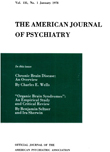PSYCHIATRIC SYNDROMES, ANXIETY SYMPTOMS AND RESPONSES TO STRESS IN MEDICAL STUDENTS
Abstract
1. A random sample of 40 sophomore medical students out of 80 was given structured psychiatric interviews.
2. Six (15%) of the group were psychiatrically ill ; of these 3 were manic-depressives, one an anxiety neurotic, one a chronic alcoholic, and one ill but undiagnosed.
3. The psychiatrically ill subjects had an incidence of positive family history of psychiatric illness that was markedly greater than that of the well subjects; this difference was statistically significant to the 0.0001 level. In addition, the ill relatives of ill subjects were not only genetically much closer than those of the well subjects but appeared to suffer different illnesses.
4. Anxiety symptoms did not increase in pre-exam periods in the psychiatrically ill; but those of well subjects, previously quite different, approached those of the ill in pre-exam periods.
5. Anxiety ratings in ordinary circumstances do not correlate with those of pre-exam periods for the group.
6. In ordinary circumstances our group resembled a control population rather than anxiety neurotics in terms of incidence of anxiety symptoms. In pre-exam periods the group resembled the "scared soldiers" reported by Cohen, White, et al. Differences, however, were present.
7. The incidence of psychiatric symptoms such as dreams, nightmares, hallucinations, suicidal thoughts, and phobias was quite high in our subjects but the quality of such symptoms was innocuous in all but the 6 ill subjects.
Access content
To read the fulltext, please use one of the options below to sign in or purchase access.- Personal login
- Institutional Login
- Sign in via OpenAthens
- Register for access
-
Please login/register if you wish to pair your device and check access availability.
Not a subscriber?
PsychiatryOnline subscription options offer access to the DSM-5 library, books, journals, CME, and patient resources. This all-in-one virtual library provides psychiatrists and mental health professionals with key resources for diagnosis, treatment, research, and professional development.
Need more help? PsychiatryOnline Customer Service may be reached by emailing [email protected] or by calling 800-368-5777 (in the U.S.) or 703-907-7322 (outside the U.S.).



